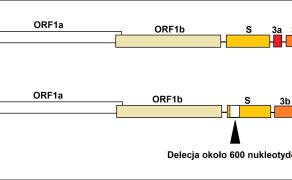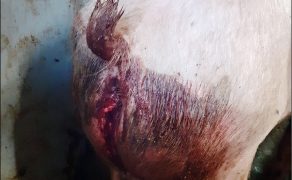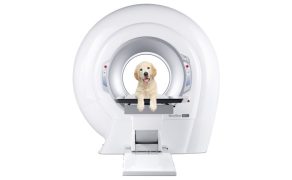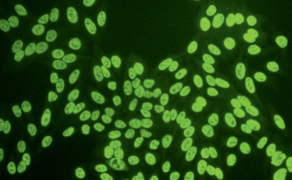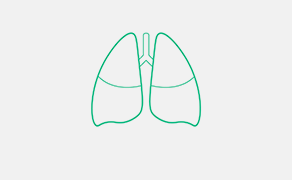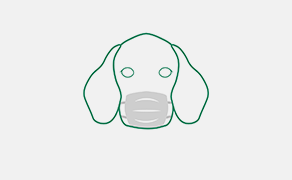Koronawirusy patogenne dla trzody chlewnej – wirus zakaźnego zapalenia żołądka i jelit
Piśmiennictwo
- Doyle L.P., Hutchings L.M.: A transmissible gastroenteritis in pigs. „J Am Vet Med Assoc”, 1946, 108, 257.
- Turlewicz-Podbielska H., Pomorska-Mól M.: Porcine Coronaviruses: Overview of the State of the Art. „Virol Sin”, 2021, 36, 5, 833-851.
- Saif L.J., Sestak K.: Transmissible gastroenteritis virus and porcine respiratory coronavirus. [In:] Diseases of Swine. Blackwell Publishing Company, Ames, IA, 2006, 489-516.
- Putics A. et al.: Identification of protease and ADP-ribose 1’’-monophosphatase activities associated with transmissible gastroenteritis virus non-structural protein 3. „J Gen Virol”, 2006, 87, 651-656.
- Yount B. et al.: Strategy for systematic assembly of large RNA and DNA genomes: transmissible gastroenteritis virus model. „J Virol”, 2000, 74, 10600-10611.
- Guo R. et al.: Characterization and evaluation of the pathogenicity of a natural recombinant transmissible gastroenteritis virus in China. „Virology”, 2020, 545, 24-32.
- Saif L.J. et al.: Coronaviruses. [In:] Diseases of Swine. John Wiley & Sons, Inc., 2019, 488-523.
- Zhang X. et al.: Identification of a natural recombinant transmissible gastroenteritis virus between Purdue and Miller clusters in China. „Emerg Microbes Infect”, 2017, 6, 8, e74.
- Cartwright S.F.: A cytopathic virus causing transmissible gastroenteritis in swine. „J Comp Pathol”, 1965, 75, 387-396.
- Haelterman E.O.: Transmissible gastroenteritis of swine. Proc 17th World Vet Congr 1, 1962, 615-618.
- Haas B. et al.: Inactivation of viruses in liquid manure. „Rev Sci Tech”, 1995, 14, 435-445.
- Enjuanes L., Van der Zeijst B.A.M.: Molecular Basis of Transmissible Gastroenteritis Virus Epidemiology. [In:] The Coronaviridae. Plenum Press, New York, USA 1995, 337-376.
- https://wahis.woah.org/#/event-management.
- Chen F. et al.: Decline of Transmissible Gastroenteritis Virus and its Complex Evolutionary Relationship With Porcine Respiratory Coronavirus in the United States. „Sci Rep”, 2019, 9, 1, 3953.
- Zhang F. et al.: Prevalence and phylogenetic analysis of porcine diarrhea associated viruses in southern China from 2012 to 2018. „BMC Vet Res”, 2019, 15, 4702.
- Xu L. et al.: Characterization and Evaluation of the Pathogenicity of a Natural Gene-Deleted Transmissible Gastroenteritis Virus in China. „Transbound Emerg Dis”, 2023, 10, 1-13.
- Valkó A. et. al.: Prevalence of antibodies against transmissible gastroenteritis virus (TGEV) in Hungary. „Vet Anim Sci”, 2019, 7, 100042.
- Lu C.Z. et al.: Establishment of double PCR detection method of transmissible gastroenteritis virus (TGEV) and porcine epidemic diarrhea virus (PEDV). „China Anim Husb Vet Med”, 2015, 42, 1377-1382.
- Zhang Q. et al.: Occurrence and investigation of enteric viral infections in pigs with diarrhea in China. „Arch Virol”, 2013, 158, 1631-1636.
- Zhu Y. et al.: A sensitive duplex nanoparticle-assisted PCR assay for identifying porcine epidemic diarrhea virus and porcine transmissible gastroenteritis virus from clinical specimens. „Virus Gene”, 2017, 53, 71-76.
- Boniotti M.B. et al.: Porcine epidemic diarrhea virus and discovery of a recombinant swine enteric coronavirus, Italy. „Emerg Infect Dis”, 22, 1, 83-87.
- Keep S. et al.: Porcine Respiratory Coronavirus as a Model for Acute Respiratory Coronavirus Disease. „Front Immunol”, 2022, 28, 13, 867707.
- Laude H. et al.: Porcine Respiratory Coronavirus: Molecular Features and Virus-Host Interactions. „Vet Res”, 1993, 24, 2, 125-50.
- Page K.W. et al.: Sequence Comparison of the 5’ End of Mrna 3 From Transmissible Gastroenteritis Virus and Porcine Respiratory Coronavirus. „J Gen Virol”, 1991, 72, 579-587.
- Rasschaert D. et al.: Porcine Respiratory Coronavirus Differs From Transmissible Gastroenteritis Virus by a Few Genomic Deletions. „J Gen Virol”, 1990, 71, 2599-2607.
- Wesley R.D. et al.: Genetic Analysis of Porcine Respiratory Coronavirus, an Attenuated Variant of Transmissible Gastroenteritis Virus. „J Virol”, 1991, 65, 6, 3369-3373.
- Pejsak Z.: Zakażenia koronawirusem płucnym. [W:] Zdrowie świń, prewencja i terapia. Polskie Wydawnictwo Rolnicze, 2021, 282-285.
- Atanasova K. et al.: Lung cell tropism and inflammatory cytokine-profile of porcine respiratory coronavirus infection. „Open Vet Sci”, 2008, 2, 117-126.
- Jung K. et al.: Porcine reproductive and respiratory syndrome virus modifies innate immunity and alters disease outcome in pigs subsequently infected with porcine respiratory coronavirus: Implications for respiratory viral co-infections. „J Gen Virol”, 2009, 90, 2713-2723.
- Jung K. et al.: Nitric oxide is elicited and inhibits viral replication in pigs infected with porcine respiratory coronavirus but not porcine reproductive and respiratory syndrome virus. „Vet Immunol Immunopathol”, 2010, 136, 3-4, 335-339.
- Cox E. et al.: Intestinal replication of a porcine respiratory coronavirus closely related antigenically to the enteric transmissible gastroenteritis virus. „Vet Microbiol”, 1990, 23, 237-243.
- Cox E. et al.: Sites of replication of a porcine respiratory coronavirus related to transmissible gastoenteritis virus. „Res Vet Sci”, 1990, 48,165-169.
- Pejsak Z.: Zakaźne zapalenie żołądka i jelit świń. [W:] Zdrowie świń, prewencja i terapia. Polskie Wydawnictwo Rolnicze, 2021, 274-279.
- Kemeny L.J. et al.: Upper respiratory infection of lactating sows with transmissible gastroenteritis virus following contact exposure to infected piglets. „Cornell Vet”, 1975, 65, 352-362.
- Kemeny L.J.: Isolation of transmissible gastroenteritis virus from pharyngeal swabs obtained from sows at slaughter. „Am J Vet Res”, 1978, 39, 703-705.
- Sedlak K. et al.: Antibodies to selected viral disease agents in wild boars from the Czech Republic. „J Wildl Dis”, 2008, 44, 777-780.
- Larson D.J. et al.: Transmissible gastroenteritis in neonatal dogs: experimental intestinal infection with transmissible gastroenteritis virus. „Am J Vet Res”, 1979, 40, 4, 477-86.
- Reynolds D.J., Garwes D.J.: Virus isolation and serum antibody responses after infection of cats with transmissible gastroenteritis virus. „Arch Virol”, 1979, 60, 161-166.
- Pilchard E.I.: Experimental transmission of transmissible gastroenteritis by starlings. „Am J Vet Res”, 1965, 26, 1177-1179.
- Gough P.M., Jorgenson R.D.: Identification of porcine transmissible gastroenteritis virus in house flies (Musca domestica Linneaus). „Am J Vet Res”, 1983, 44, 2078-2082.
- Underdahl N.R. et al.: The effect of cytopathogenic transmissible gastroenteritis-like viruses and of Escherichia coli on germ-free pigs. „Canad Vet J”, 1972, 13, 9-16.
- Brim T.A. et al.: Cellular immune responses of pigs after primary inoculation with porcine respiratory coronavirus or transmissible gastroenteritis virus and challenge with transmissible gastroenteritis virus. „Vet Immunol Immunopathol”, 1995, 48, 35-54.
- Cox E. et al.: Intestinal protection against challenge with transmissible gastroenteritis virus of pigs immune after infection with the porcine respiratory coronavirus. „Vaccine”, 1993, 11, 267-272.
- VanCott J.L. et al.: Contribution of antibody-secreting cells induced in mucosal lymphoid tissues of pigs inoculated with respiratory or enteric strains of coronavirus to immunity against enteric coronavirus challenge. „J Immunol”, 1994, 152, 3980-3990.
- Saif L.J. et al.: Immunity to transmissible gastroenteritis virus and porcine respiratory coronavirus infections in swine. „Vet Immunol Immunopathol”, 1994, 43, 89-97.
- VanCott J.L. et al.: Isotype-specific antibody-secreting cells to transmissible gastroenteritis virus and porcine respiratory coronavirus in gut- and bronchus-associated lymphoid tissues of suckling pigs. „J Immunol”, 1993, 150, 3990-4000.
- Wesley R.D., Woods R.D.: Induction of protective immunity against transmissible gastroenteritis virus after exposure of neonatal pigs to porcine respiratory coronavirus. „Am J Vet Res”, 1996, 57, 157-162.
- Hooper B.E., Haelterman E.O.: Concepts of pathogenesis and passive immunity in transmissible gastroenteritis of swine. „J Am Vet Med Assoc”, 1966, 149, 1580-1586.
- Stepanek J. et al.: Epizootiology, diagnosis and prevention of viral diarrhea in piglets under intensive husbandry conditions. 21st World Veterinary Congress, Moscow 1979, 43.
- Liu Q., Gerdts V.: Transmissible Gastroenteritis Virus of Pigs and Porcine Epidemic Diarrhea Virus Coronaviridae. [In:] Encyclopedia of Virology. Elsevier, 2021, 850-853.
lek. wet. Hanna Turlewicz-Podbielska*
lek. wet. Łukasz Kobyłka**
prof. dr hab. Małgorzata Pomorska-Mól*
* Katedra Nauk Przedklinicznych i Chorób Zakaźnych
Wydziału Medycyny Weterynaryjnej i Nauk o Zwierzętach
Uniwersytetu Przyrodniczego w Poznaniu
** Usługi weterynaryjne Łukasz Kobyłka w Opolu
Galeria
Mogą zainteresować Cię również
Znajdź swoją kategorię
2814 praktycznych artykułów - 324 ekspertów - 22 kategorii tematycznych
Weterynaria w Terenie

Praktyka w terenie – jak zabezpieczyć się na wypadek stanów zagrożenia życia lub zdrowia zwierzęcia
Piśmiennictwo mec. Anna SłowińskaVox Poland Pomoc PrawnaSzczecin Facebook0Tweet0LinkedIn0

Choroby racic jako ważna przyczyna brakowania krów w stadzie bydła mlecznego
Czynniki zakaźne – zakażenia bakteryjne Zakaźne zapalenie tworzywa racicowego (łac. pododermatitis septica). Choroba wywoływana jest najczęściej przez bakterie ropotwórcze i martwicowe (łac. Trueperella pyogenes, Fusobacterium necrophorum lub Bacteroides melaninogenicus). Bakterie bytują w środowisku, w wilgotnym, zanieczyszczonym podłożu. Urazy, pęknięcia rogu racicowego, uszkodzenia mechaniczne części nośnej i podeszwy, a szczególnie w okolicy linii białej, mogą stanowić […]
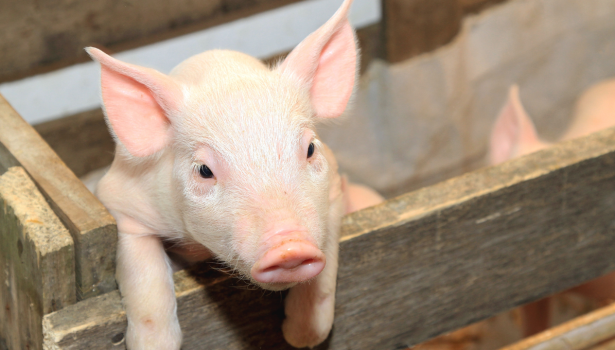
Czynniki wpływające na kolonizację mikrobiomu i dojrzałość układu pokarmowego prosiąt oraz jego prawidłowe funkcjonowanie
Piśmiennictwo dr inż. Piotr Nowak Facebook0Tweet0LinkedIn0
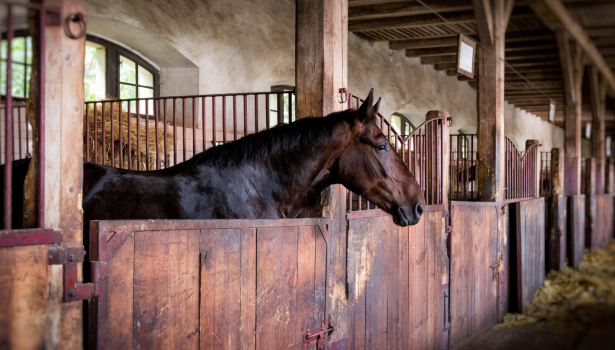
Opieka stomatologiczna nad starszymi końmi
Piśmiennictwo lek. wet. Katarzyna FerenzGabinet weterynaryjny Końskie Zdrowie we Wrocławiu Facebook0Tweet0LinkedIn0

Praktyka w terenie – jak zabezpieczyć się na wypadek stanów zagrożenia życia lub zdrowia zwierzęcia
Piśmiennictwo mec. Anna SłowińskaVox Poland Pomoc PrawnaSzczecin Facebook0Tweet0LinkedIn0
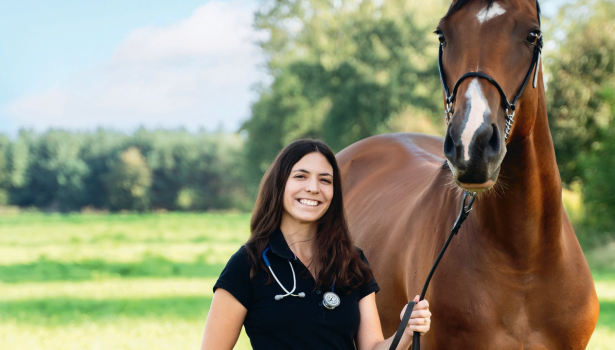
Wiek ma ogromne znaczenie podczas stawiania diagnozy
Lek. wet. Justyna Domagała tytuł inżyniera zootechniki uzyskała w 2016 r., a tytuł lekarza weterynarii – w 2019 r. na Uniwersytecie Przyrodniczym we Wrocławiu. Po studiach swoją wiedzę poszerzała podczas stażu w Szpitalu dla Koni Equivet, w którym później uzyskała zatrudnienie. W latach 2021-2024 swoją pracę skupiała na internistycznym leczeniu koni oraz pogłębianiu wiedzy na […]
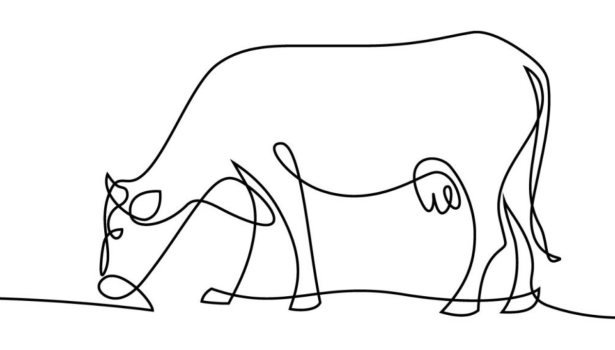
Echa 32. Kongresu Bujatrycznego w Cancun
Profilaktyka Kongres był również okazją do zaprezentowania kilku przełomowych produktów immunologicznych, które mają szansę wprowadzić na nowe tory prewencję znanych od lat jednostek chorobowych, sprawiających wiele kłopotów z punktu widzenia odchowu cieląt czy rozrodu. Mowa tu konkretnie o trzech nowych szczepionkach mających zastosowanie w profilaktyce Mycoplasma bovis, Cryptosporidium parvum czy wirusowej biegunki bydła (BVD). Nie […]


